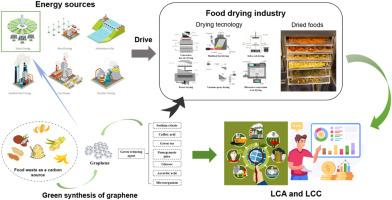石墨烯纳米材料在食品干燥中的节能减排研究进展
IF 15.4
1区 农林科学
Q1 FOOD SCIENCE & TECHNOLOGY
引用次数: 0
摘要
近年来,食品干燥行业的能耗和环境问题日益严重。为了实现食品干燥的绿色和可持续发展,从业者做了很多尝试。石墨烯纳米材料以其超高导热系数、广谱光热转换效率、可控吸附等特性,为突破食品干燥领域的瓶颈提供了创新路径。本研究首次系统地描述了石墨烯纳米材料的独特性质及其在食品干燥工业中的潜在应用。此外,详细总结了石墨烯及其各种衍生物的各种合成途径,并基于生命周期分析,评估了石墨烯技术通过提高能源效率来减少食品干燥行业对环境影响的潜力。最后,提出了石墨烯纳米材料在食品干燥工业中的应用面临的挑战和解决方案。将石墨烯技术集成到食品干燥中,可以显著降低干燥过程中的热损失,提高能量利用效率和传热传质效率,提高产品质量,减少碳排放。基于石墨烯纳米材料的食品干燥创新技术的发展具有巨大的潜在环境和经济效益。本文章由计算机程序翻译,如有差异,请以英文原文为准。

Using of graphene nanomaterials for energy saving and emission reduction in food drying: A review
Background
In recent years, energy consumption and environmental problems in the food drying industry have become increasingly serious. To realize green and sustainable food drying, practitioners have made a lot of attempts. Graphene nanomaterials, with their ultra-high thermal conductivity, broad-spectrum photothermal conversion efficiency, and controllable adsorption characteristics, provide an innovative path to break through the bottleneck in the field of food drying.
Scope and approach
In this study, the unique properties of graphene nanomaterials and their potential applications in the food drying industry are systematically described for the first time. In addition, the various synthetic pathways of graphene and its various derivatives are summarized in detail, and based on life cycle analysis, the potential of graphene technology to reduce the environmental impact of the food drying industry by improving energy efficiency is evaluated. Finally, the challenges and solutions for the integration of graphene nanomaterials in the food drying industry are presented.
Key findings and conclusions
Integration of graphene technology in food drying can significantly reduce heat loss in the drying process, improve energy utilization efficiency and heat and mass transfer efficiency, improve product quality, and reduce carbon emissions. The development of innovative technologies based on graphene nanomaterials in food drying has enormous potential environmental and economic benefits.
求助全文
通过发布文献求助,成功后即可免费获取论文全文。
去求助
来源期刊

Trends in Food Science & Technology
工程技术-食品科技
CiteScore
32.50
自引率
2.60%
发文量
322
审稿时长
37 days
期刊介绍:
Trends in Food Science & Technology is a prestigious international journal that specializes in peer-reviewed articles covering the latest advancements in technology, food science, and human nutrition. It serves as a bridge between specialized primary journals and general trade magazines, providing readable and scientifically rigorous reviews and commentaries on current research developments and their potential applications in the food industry.
Unlike traditional journals, Trends in Food Science & Technology does not publish original research papers. Instead, it focuses on critical and comprehensive reviews to offer valuable insights for professionals in the field. By bringing together cutting-edge research and industry applications, this journal plays a vital role in disseminating knowledge and facilitating advancements in the food science and technology sector.
 求助内容:
求助内容: 应助结果提醒方式:
应助结果提醒方式:


